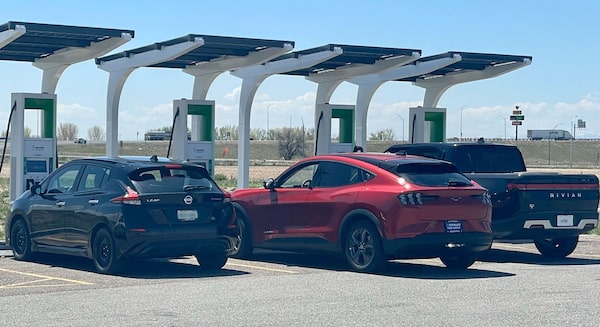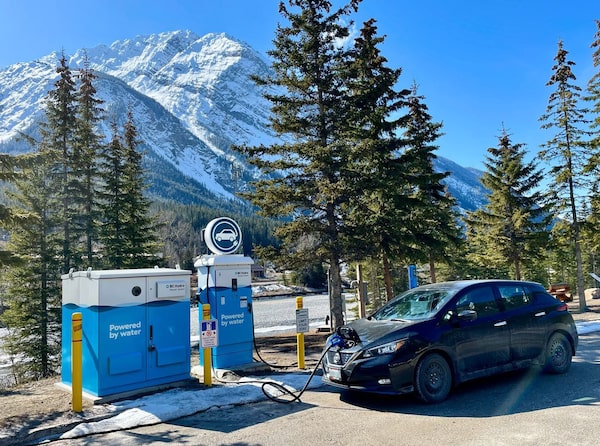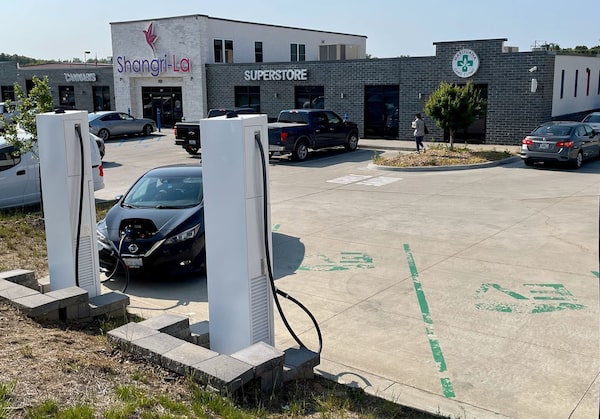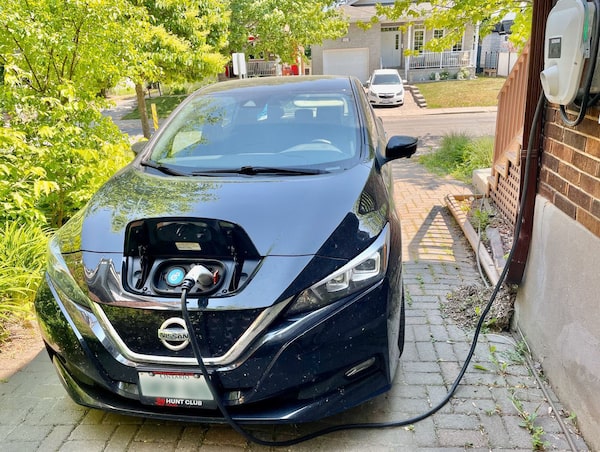
The charging station in Heyburn, Idaho was busy when I visited in early May. That's because it is the last fast charger going south for another 200 kilometres.Paul Adams/The Globe and Mail
Paul Adams is a retired professor and a former Globe and Mail reporter in Ottawa and the Middle East. He has owned an EV since 2020.
It was before dawn on April Fool’s Day when I set out from Wawa, Ont., for Thunder Bay in my 2020 all-electric Nissan Leaf. It was the third day of my planned 14,000-kilometre journey from Ottawa to Victoria, returning through the United States.
The temperature was minus nine and there was a howling wind off Lake Superior to the south, blowing sheets of powdery snow across the highway. When I was planning this trip, I knew that this was the day when there would be the fewest opportunities to charge.
In the showroom, they will tell you that my model of Leaf can get 400 kilometres on a charge. Perhaps in perfect conditions — in the city on a pleasant spring day. But electric vehicles get less mileage in the cold and at highway speeds. When I left Wawa, the algorithm in the car told me my range was likely a little more than 300 kilometres, but I could quickly see my projected range dropping much more quickly than the distance to my destination.
I was aiming for the Ivy chargers in White River, 93 kilometres out. I knew from experience in Southern Ontario that the Ivy Charging Network (a joint venture of Hydro One and Ontario Power Generation) was not especially reliable. But my hope was to do an insurance charge-up there so I could get to the charger after that, a Petro-Canada in Marathon.
Even before I reached White River, I was starting to worry. The temperature had dropped to minus 13. I turned off the electric luxuries like the warmers for the seat and the steering-wheel and then, as I got more nervous, I dropped my speed to 85 kilometres an hour and started turning off the interior heat from time to time.

This B.C. Hydro charger in Field, B.C. was the only one in the entire trip that you could call beautifully situated. And there was a public restroom nearby.Paul Adams/The Globe and Mail
When I reached White River, I pulled up to the Ivy chargers. Their video screens were an empty dull grey, and when I went on the Ivy app to put in my co-ordinates, it said the chargers were “unavailable.”
It was almost another 100 kilometres to Marathon.
I now dropped my speed to 65 to save battery power. When semi trucks appeared in my rear-view mirror, coming in at full speed, I would put on my flashers and pull over to the shoulder so they could whiz by. I was turning my heater off for longer periods and my feet were getting painfully cold. I would give the windshield a brief zap every now and again to keep it clear.
I began to worry whether my clothes were warm enough if I got into real trouble.
When I finally reached the charger in Marathon, it was minus 20 with the wind chill and my teeth literally chattered as the Petro-Canada app refused to open on my phone. Nor would the terminal recognize my credit card. But finally, it did accept the card in my phone wallet. I was charging.
That was the worst day in 10 mainly wonderful weeks that included all the joys of a long-distance road trip: seeing old friends, exploring new places, hiking, taking pictures and crossing the Rockies twice.
But that day north of Superior illustrated some of the problems that face North America as the rush is on to replace our vast gas-guzzling fleet of vehicles with EVs. In pursuit of our climate goals, Canada has mandated that 60 per cent of new car sales be EVs by 2030, just seven years away, and 100 per cent by 2035. But the fast-charging network is not nearly as robust as it needs to be. There aren’t enough chargers in enough places, and way too many of them don’t work well or don’t work at all.
When I am at home in Ottawa, the car is perfect. It cost me only a little more than the average car sold nowadays in Canada, in part because of the $5,000 federal subsidy. I have a Level 2 charger at home that will fill the battery overnight on 240 volts. The charging unit cost me about $1,500 to install, including an upgrade to my electrical panel, and since then I have spent about a quarter of what I would to fuel a regular car.
But as soon as I hit the road – which I am doing more these days because I am retired and because I am trying to cut back on air travel, also for environmental reasons — life becomes complicated.
First of all, there’s the time it takes even at a “fast-charger.” When I got the car, I thought, well, I love to walk. I’ll just go for a stroll whenever the car is charging. I had not thought that the chargers are usually located on service islands where there’s nowhere to go or in dreary retail strips where there’s nowhere you want to go.
Then one day on a trip to Quebec City with my daughter, Sophia, I noticed that when we stopped to charge, she popped open her laptop and did some school work.
Unsold electric vehicles are piling up – people like the idea but are not buying them
So, I decided to post periodically on the Substack platform about my trip, and pass the time writing and processing my photographs. This worked well, at least when there was a coffee shop or restaurant nearby and if I was charging just once or twice in a day; but admittedly it got a little old if I charged a third time. And the more often you charge, the slower it goes as the car throttles up to keep the battery from overheating. You hope you won’t have to stop for more than half an hour; occasionally it can be more like a full hour.
But for me, a bigger issue was the sheer mental exhaustion of constantly planning where to charge — and what to do if something went wrong. In Merritt, B.C., the specific connector I needed for my car was broken at the Canadian Tire. Across the street, the Petro-Canada chargers were down. Luckily, my last option, a brand new charger at a convenience store, did work. If it hadn’t, it was another 63 kilometres to the next charger, and who’s to say what condition it was in?
In Canada, I drove mainly along the Trans-Canada Highway, which is better served than elsewhere. I abandoned a plan to drive the Icefields Parkway between Banff and Jasper for lack of chargers. I had a similar issue in the U.S. with the Great Plains states.
A friend and I had arranged to meet up and tour around the Palouse region of eastern Washington state — a photographer’s dream for its painterly landscapes. I had used my PlugShare app, which is generally reliable for identifying charger locations, and saw there was a lonely pair of ChargePoint chargers in the region at a casino near the sister cities of Lewiston, Idaho and Clarkston, Washington. (Yes, Lewiston and Clarkston — get it?) But when I got there, the chargers hadn’t been set up. I felt defeated when I suggested to my buddy that we rent a gas-powered car for a few days as the only practical way to tour the region. We rented a Nissan Sentra for two days. It was definitely worth it.
Even where there are chargers, they can be frustrating to use. In the American Midwest, I needed to use a charger from a company that was new to me. I downloaded the app but it wouldn’t take my Canadian credit card. Luckily the operator at the help line answered promptly and was able to start the charge remotely.

Fast chargers can be anywhere from a Walmart to a multi-story carpark or a highway service island. This one in Columbia, Mo. is outside the Shangri-La Cannabis Superstore.Paul Adams/The Globe and Mail
Frankly, I do not understand why all the charging networks don’t allow you just to tap and pay. You can do this with the Electrify America chargers in the United States, which I also found to be the best maintained. (The Electrify America network, mostly based in Walmart parking lots, emerged from the Volkswagen emissions scandal and is part of the company’s settlement.)
One issue I did not encounter, which I often hear discussed by non-EV owners, is lineups at charging stations. That happened to me just once in 2½ months. Still, it is hard to know the future as the number of chargers grows but so does the number of EVs. It is difficult to imagine that this will be perfectly synchronized.
My Tesla-owning friends serenely tell me that with their longer-range cars, faster charging and seamlessly efficient charging network, they face none of these problems.
But the solution to our climate challenge can’t possibly be that everyone runs out and buys an $80,000 car.
Before your road trip
Map out your route using the sometimes clunky but generally reliable PlugShare app. This will help you identify the fast-chargers available to you (where they exist).
Have a Plan A and a Plan B (and maybe a Plan C). You don’t want your battery to be down to 20 per cent and facing a long drive to the next charger.
Download the apps for any charging company you expect to encounter and set them up for payment before you leave home. The last thing you need is to waste time fiddling with an app when you arrive at a charger (especially in winter). On the American apps, try using just the numbers from your postal code, or even all zeros, if they won’t accept your address.

At the end of the journey, my car is once again charging at the Level 2 charger I have at home.Paul Adams/The Globe and Mail
Remember that it is hard on an EV’s battery to fast-charge past 80 per cent and the car may throttle the speed of your charge as it nears capacity.
PlugShare or other similar apps will also locate Level 2 chargers that will charge your car overnight and which are easier on the battery. More and more hotels have these chargers, as well as shopping malls, parking lots and public buildings. Some of them are even free.